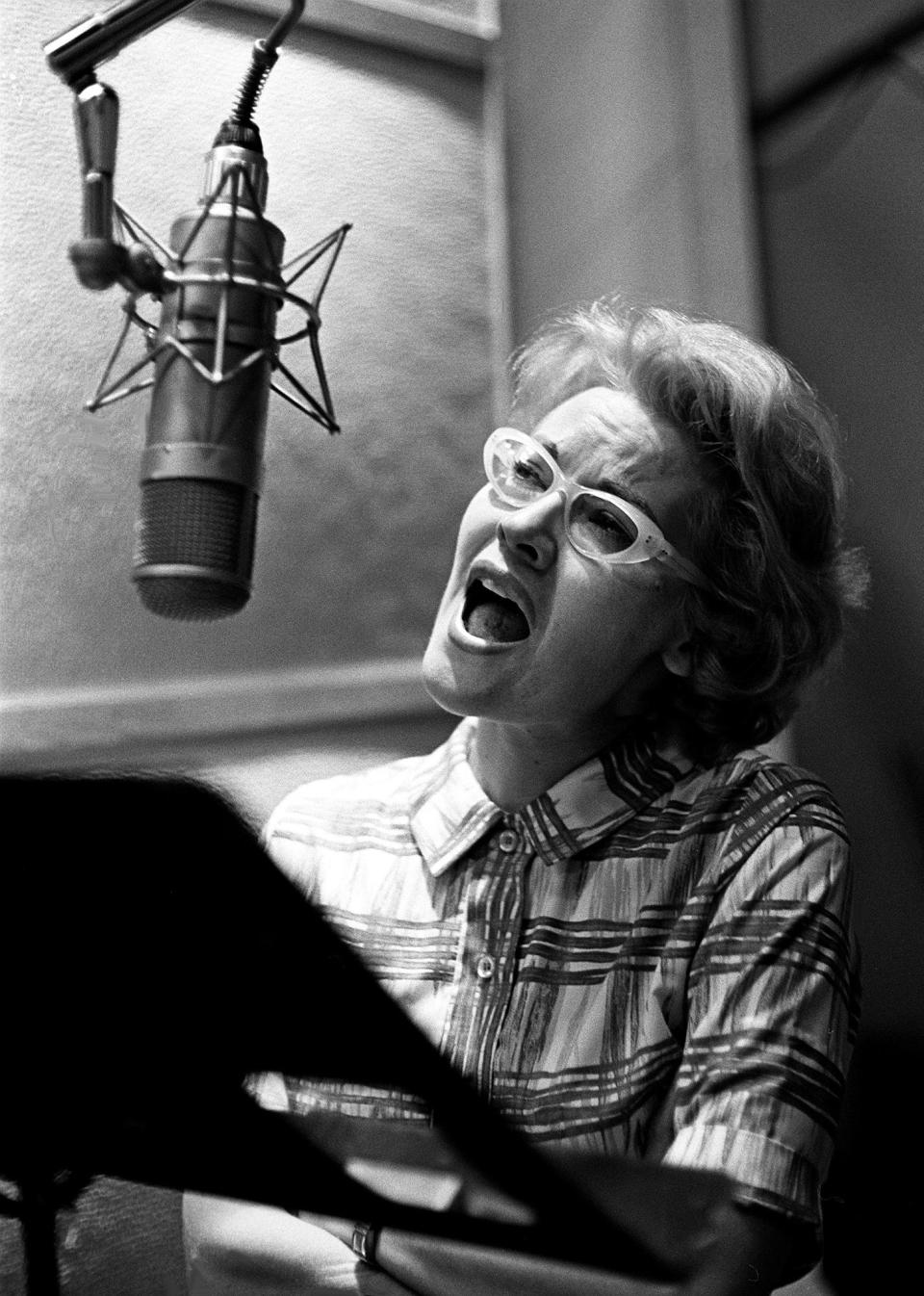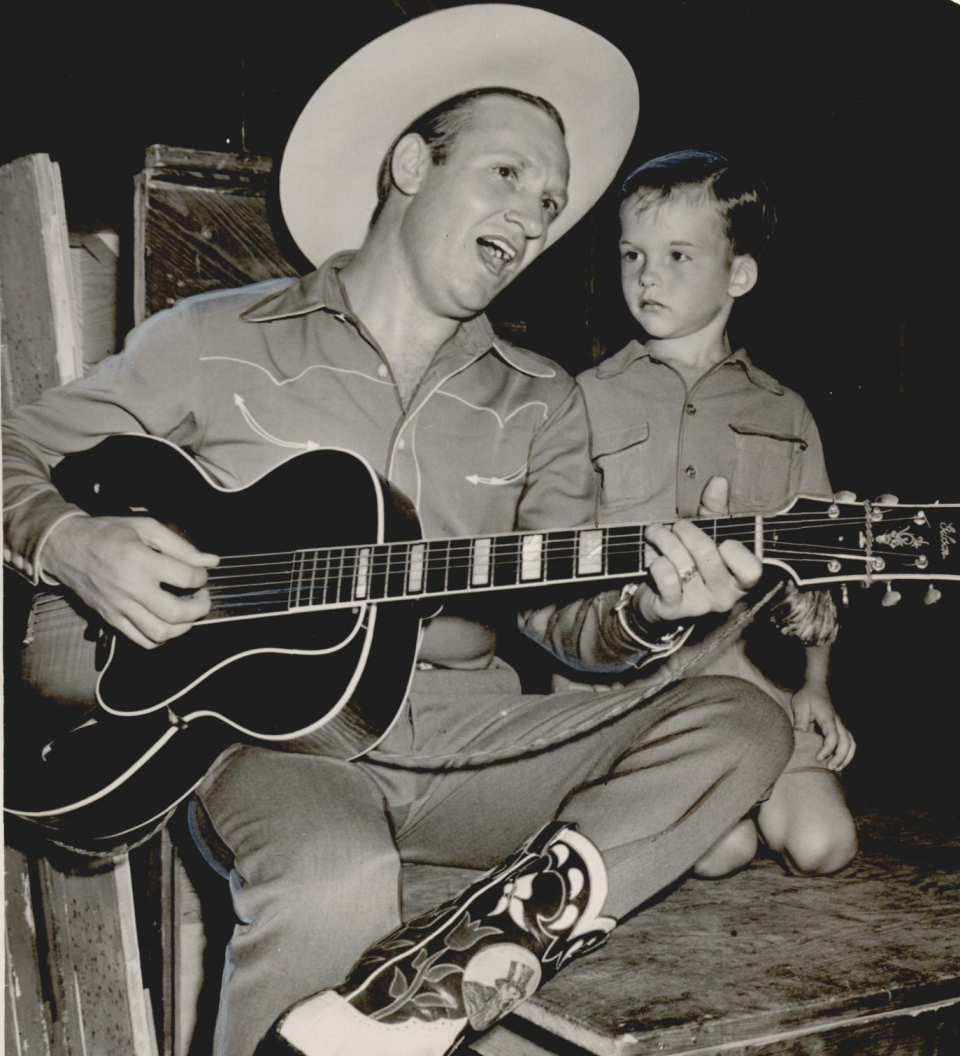Songs by 3 iconic Oklahomans selected for National Recording Registry: What you need to know
A classic Christmas story-song crooned by an iconic "Singing Cowboy" who grew up in southern Oklahoma, a top-selling torch song warbled by the "Singing Rage" from Claremore and a jazz standard featuring a trailblazing guitarist from OKC are joining the National Recording Registry.
Gene Autry’s 1949 holiday hit “Rudolph, the Red-Nosed Reindeer," Patti Page’s 1950 smash “Tennessee Waltz" and the Benny Goodman Sextet's 1939 recording of “Rose Room” with Charlie Christian are among the 25 recordings Librarian of Congress Carla Hayden named Tuesday as audio treasures worthy of preservation based on their cultural, historical or aesthetic importance in the nation’s recorded sound heritage.

The three songs — along with ABBA’s “Dancing Queen"-powered breakthrough "Arrival," Blondie’s era-defining “Parallel Lines,” The Notorious B.I.G.’s seminal album “Ready to Die,” Green Day’s major-label debut “Dookie,” The Chicks’ sweeping 1998 country collection “Wide Open Spaces” and Lily Tomlin’s 1971 comedy album "This Is a Recording" — have been selected for the Library of Congress' roster of 650 significant recordings.
The 2024 class also includes The Cars’ 1978 self-titled debut album, Perry Como’s celestial ditty “Catch a Falling Star” / “Magic Moments,” Juan Gabriel’s heartbreaking ballad “Amor Eterno,” Héctor Lavoe’s salsa hit “El Cantante,” Kronos Quartet’s cross-cultural landmark “Pieces of Africa,” Johnny Mathis’ piano ballad “Chances Are,” Bobby McFerrin’s earworm “Don’t Worry, Be Happy" and Bill Withers’ soulful lament “Ain’t No Sunshine.”

What is the National Recording Registry?
Under the terms of the National Recording Preservation Act of 2000, the Librarian of Congress, with advice from the National Recording Preservation Board, selects 25 titles each year that are “culturally, historically, or aesthetically significant” and are at least 10 years old.
A record 2,899 nominations were made by the public this year for recordings to consider adding to the National Recording Registry. The public can submit nominations throughout the year. Nominations for next year will be accepted until Oct. 1, 2024.
The latest selections named to the registry span from 1919 to 1998. They range from the single “Clarinet Marmalade," made by the all-Black 369th U.S. Infantry Band led by James Reese Europe after World War I, and the 1928 recording “Kauhavan Polkka," by Viola Turpeinen and John Rosendahl, to Jefferson Airplane's 1967 psychedelic rock album “Surrealistic Pillow” and J.D. Crowe & the New South's seminal 1975 self-titled bluegrass collection.
How did Gene Autry make 'Rudolph, the Red-Nosed Reindeer' an enduring holiday hit?
Born Orvon Gene Autry on Sept. 29, 1907, on a small tenant farm near Tioga, Texas, famed actor, singer and rodeo performer Gene Autry was just a baby when his family moved to southern Oklahoma, where he grew up near Achille and Ravia.
Legend has it that Autry was singing and playing his guitar while filling in for a telegrapher in Chelsea when “Oklahoma’s favorite son” Will Rogers came into the office to dispatch his daily syndicated column. Impressed with Autry's talents, Rogers encouraged him to keep singing, so Autry headed to New York in 1927 to "make a record."
He soon returned to the Sooner State as "Oklahoma's Yodeling Cowboy" on Tulsa’s KVOO radio and found fame in the fledgling Hollywood movie industry and later in the early television biz.
The "Singing Cowboy" star first became tied to Christmas in 1947, when he wrote, recorded and released on Columbia Records the hit “Here Comes Santa Claus (Right Down Santa Claus Lane).”
Taking his cues from Clement Moore’s 1820s poem “A Visit from Saint Nicholas” (now known as "Twas the Night Before Christmas”), Chicago copywriter Robert L. May in 1939 created the character of “Rudolph the Red-Nosed Reindeer” for Montgomery Ward’s annual promotional coloring booklet. The retailer distributed 2.4 million copies of the booklet that year, and soon after, Johnny Marks, May’s brother-in-law, decided to turn the story into a song.
Already a Christmas hitmaker, Autry wasn’t sure if Rudolph’s story-song suited his style, but his wife, Ina Autry, liked the song and convinced him to croon it. The Singing Cowboy recorded it in 1949, and the folksy yuletide yarn raced to the top of the charts.
By the time Autry died in 1998, "Rudolph the Red Nosed Reindeer" had sold 10 million copies and become a perennial holiday favorite.
How did 'Tennessee Waltz' help make Patti Page one of the top-selling female vocalists of all time?
Over her seven-decade music career, Patti Page became known as one of the top-selling female vocalists of all time, a sultry-voiced songstress who earned the colorful nickname the "The Singing Rage" by crooning lasting hits like "Tennessee Waltz," “Doggie in the Window” and “Old Cape Cod."
Born Clara Ann Fowler Nov. 8, 1927, in Claremore, the future hitmaker was still a teenager when she started singing professionally at Tulsa radio station KTUL, adopting her stage name from one of the station's sponsors, the Page Milk Company.
Page signed a contract in 1947 with Mercury Records and made music history with one of her early hits: 1948's "Confess" was the first song to use vocal overdubbing, with Page backing up herself on the record.
Inducted into the Oklahoma Music Hall of Fame as part of its inaugural 1997 class, Page recorded more than 1,000 songs, had 111 singles make the Billboard charts and earned 24 top 10 hits, including four No. 1s. But she is best remembered for her signature smash: 1950's "Tennessee Waltz" was a song written by country music stalwarts Redd Stewart and Pee Wee King that she longed to record but her label rejected.
With Christmas approaching, Mercury Records wanted Page to record “Boogie Woogie Santa Claus," eventually letting her record "Tennessee Waltz" for the flipside. While the yuletide A-side has largely been forgotten, the B-side "Tennessee Waltz" became an early country crossover hit and sold more than 10 million copies, ranking at the time behind only Bing Crosby's "White Christmas."
The No. 1-selling female vocalist from 1950 to 1997 — it took Celine Dion to knock her off the top of the list — Page sold a million copies of sheet music alone for "Tennessee Waltz."
"Tennessee Waltz" was inducted into the Grammy Hall of Fame in 1998. Page was bestowed a Grammy Lifetime Achievement Award a month after her death on Jan. 1, 2013, at the age of 85.
How did Charlie Christian change the way we hear electric guitars?
Guitarist Charlie Christian's tenure with the Benny Goodman Sextet is considered a pivotal moment in the development of jazz and amplified guitar in the 20th century.
Born July 29, 1916, in Bonham, Texas, to a musically inclined family, Christian grew up in Oklahoma City and became immersed in the Deep Deuce neighborhood's thriving jazz scene. In 1937, he began to play an amplified guitar, after becoming a student of Eddie Durham, who invented it.
Christian earned a reputation as a gifted player and gained the attention of promoter and producer John Hammond, who recommended the guitarist to a skeptical Goodman.
The jazz standard “Rose Room” became Christian’s impromptu audition for Goodman's popular band: During a live concert in Beverly Hills, Hammond helped the guitarist sneak his bulky amplifier on stage during intermission. Despite Goodman’s evident surprise, the performance continued because of the live audience, and Christian wowed the crowd with an extended 45-minute version of “Rose Room" that convinced the famed bandleader to add the guitarist to his sextet.
Until Christian came along, guitars had been limited to a supporting role in jazz, since acoustic guitars were too quiet to project over an ensemble. Playing remarkable licks and solos with an amplifier, Christian helped establish the guitar as a lead instrument instead of just part of the rhythm section. He also became one of the pioneers of the bebop style of jazz before his death on March 2, 1942, of tuberculosis at age 25.
Recordings Selected for the 2024 National Recording Registry (in chronological order)
“Clarinet Marmalade” – Lt. James Reese Europe’s 369th U.S. Infantry Band (1919)
“Kauhavan Polkka” – Viola Turpeinen and John Rosendahl (1928)
Wisconsin Folksong Collection (1937-46)
“Rose Room” – Benny Goodman Sextet with Charlie Christian (1939)
“Rudolph, the Red-Nosed Reindeer” – Gene Autry (1949)
“Tennessee Waltz” – Patti Page (1950)
“Rocket ‘88’” – Jackie Brenston and His Delta Cats (1951)
“Catch a Falling Star” / ”Magic Moments” – Perry Como (1957)
“Chances Are” – Johnny Mathis (1957)
“The Sidewinder” – Lee Morgan (1964)
“Surrealistic Pillow” – Jefferson Airplane (1967)
“Ain’t No Sunshine” – Bill Withers (1971)
“This is a Recording” – Lily Tomlin (1971)
“J.D. Crowe & the New South” – J.D. Crowe & the New South (1975)
“Arrival” – ABBA (1976)
“El Cantante” – Héctor Lavoe (1978)
“The Cars” – The Cars (1978)
“Parallel Lines” – Blondie (1978)
“La-Di-Da-Di” – Doug E. Fresh and Slick Rick (MC Ricky D) (1985)
“Don’t Worry, Be Happy” – Bobby McFerrin (1988)
“Amor Eterno” – Juan Gabriel (1990)
“Pieces of Africa” – Kronos Quartet (1992)
“Dookie” – Green Day (1994)
“Ready to Die” – The Notorious B.I.G. (1994)
“Wide Open Spaces” – The Chicks (1998)
This article originally appeared on Oklahoman: National Recording Registry adds three iconic Oklahoman songs
